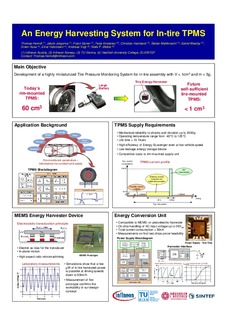| dc.description.abstract | State of the art Tire Pressure Monitoring Systems (TPMS) are wireless sensor nodes mounted on the rim. Attaching the node on the inner liner of a tire allows sensing of important additional technical parameters, such as road condition, tire wearout, temperature, tire friction, side slip, wheel speed, and vehicle load. They may be used for improved tracking and engine control, feedback to the power train and car-to-car communication purposes. Those new features come at a price: * the maximum weight of the whole sensor system is limited to 5 grams * robustness is required against extreme levels of acceleration of up to 3000g (g = 9.81 m/s2) * a 10 years lifetime must be achieved. Therefore one must get rid of bulky and heavy batteries. We like to present at the workshop our progress made on the development of a vibration based energy harvester power supply unit for a self-sufficient tire-mounted wireless sensor node, consisting of 2 major building blocks: Transducer unit: Vibration energy harvesters can be based on either of three mechanical to electrical conversion mechansims: electromagnetic, piezoelectric and electrostatic. We have designed a MEMS energy harvester for TPMS applications utilizing an electrostatic transduction principle and an electret as a bias for the transducer. Major challenges are the conflict between inertial mass size and the desire for miniaturization, to obtain reasonable efficiency (high unloaded Q and high coupling) and to make a reliable internal biasing through the use of an electret. Initial simulations of our first degins shows that output power of few uW is possible utilising the motion in a car tire and measurements of a first prototype confirms the workability of our design concept. Energy conversion unit: The conversion of harvested energy, provided by a transducer, to voltage levels suitable for energy storage is an other important issue. Challenges are a high conversion efficiency for a wide range of input power levels, integrati | |
